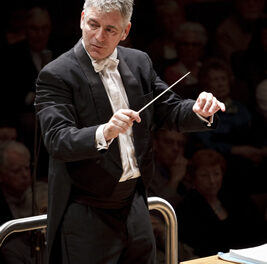Duke Performances presented the Escher String Quartet and the Dover String Quartet in a concert of three octets in Baldwin Auditorium. Both ensembles have earned recognition for expressive interpretations and their distinctive rich, warm sound.
The three works on the program were written while the composers, Shostakovich, Mendelssohn, and Enescu were still in their teens and demonstrate amazing precocious virtuosity.
Shostakovich began work on his Op. 11 for string octet while he was completing his First Symphony. He had outlined a plan for a five-movement suite and had sketches for a prelude and a fugue. The symphony, however, took precedence, and when he returned to the octet, he was no longer interested in investing the time in such an extensive work for string octet. He abandoned the fugue idea and wrote a scherzo as a balance for the prelude. Thus, we have the Two Pieces for String Octet, Op. 11.
The Prelude is rather fragmented, introducing melodies that are not developed or fully concluded, yet present clever ideas and make good use of the octet resources. The music of the scherzo is somewhat edgy, rhythmically energetic, and with pithy dissonances. If you listened carefully, you might have caught a few statements of that rhythmic pattern from Rossini’s William Tell Overture that Shostakovich found so intriguing later. He conveyed to a friend that he was especially pleased with the scherzo.
From the beginning of the concert, the Escher-Dover combined quartets produced a remarkably smooth velvety sound. Whether playing a unified homophonic passage or a break-neck run against rapidly repeated notes, or in polyphony, that warm velvety sound was evident, never mushy or murky. Pizzicato and staccato passages were crisp, clean and exciting and still conveyed that wonderful velvety sonority.
The Octet in E-flat, Op. 20, by Felix Mendelssohn is just one of the amazing youthful masterpieces he produced from chamber music to string symphonies to fully orchestrated jewels. The music of the first movement Allegro moderato flows as naturally as a mountain rill or as a flower opening to the sun. All the elements of fine ensemble playing were demonstrated by the combined quartets; marvelous bowing work, precise attacks, cut offs and tempi changes, balanced dynamics, a gorgeous blend and awesome solo work throughout. The work continues with the lilting Andante movement, as gentle, warm and comforting as a lullaby, it soars above like an Autumn sunset. The third movement is a sparkling Scherzo, full of dreams of promise and hope for tomorrow. And then we move on the magic wings of the Presto onward with our burdens reduced and our steps lighter.
Designing his String Octet, 18-year-old George Enescu decided to pursue a “cyclic” form in which a small network of melodies span across the four movements with the intention of creating a single unified and organic statement. He struggled with it for over a year before completing it to his satisfaction.
The first movement, marked Très modéré, begins with an expansive homophonic presentation of one of the main recurring themes. A second theme is laid out by a violin solo followed by viola and developed in daunting polyphonic playing. In this beginning, Enescu has well laid the groundwork for his massive chamber work. There is a mood change and a modulation to the key of D major. As the music develops more complicated rhythmic pattern appear, triplets against four quavers and such. Another lovely melody is introduced by one of the violas as the movement builds. Though the key signature is still D, the harmony grows briefly vicious, then lyrical with a few more mean chords slashing in. Along here the first violin plays exquisitely one of the charming melodies from an earlier theme. A few more quiet turns and we come to the end of the first movement. The time changes to cut time, the key signature transposes to A-flat major and we are launched into the explosive second movement, a massive fugue. The beautiful third movement, marked Lentement, is a mysterious nocturne, ethereal, sad but not despairing. The finale, Mouvement de Valse bien rythmé. is an extraordinary and wild waltz that combines many of the themes of the earlier movements into a stunning synthesis. Key signatures change, tempo indicators keep performing artists on their toes. With about five minutes to go we heard a full statement of the closing heroic theme. The music grows in intensity and just when you don’t believe it can get any more intense – it does. After a brief pause, which heightens the tension just that much more, the strings take off in what two and a half centuries ago would have been called a Mannheim Rocket, only to fall to earth and drive a C major stake firmly into the ground with a D-flat hammer. It was spectacular. It is probably the most powerful and overwhelming expression in all chamber music.
The combined forces of the Escher String Quartet and the Dover String Quartet maintained all of the technical and interpretive skills they brought to the music hall tonight. Their balanced beautiful velvety sound throughout this daunting program was amazing.











